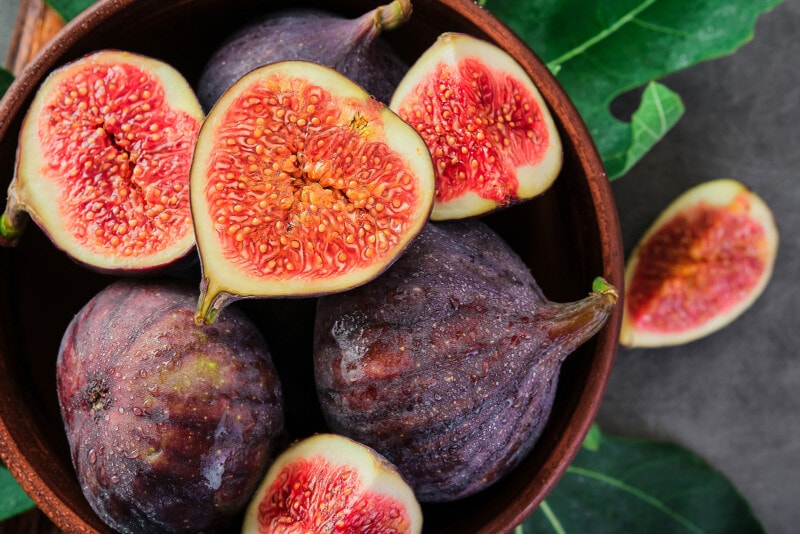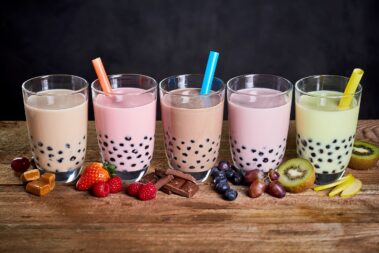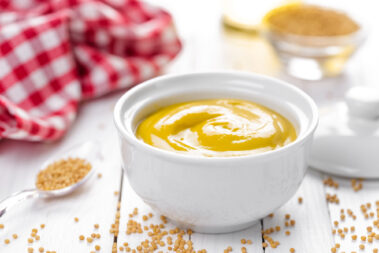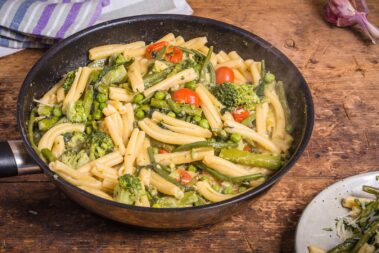If you’re questioning whether or not a fig is vegan, then you’ve no doubt heard the odd rumors about this fruit. If you don’t know why there are questions about the vegan standing of figs, then brace yourself, you’re in for a ride.
In this article, we take a deep dive into the claim that figs have dead wasps in them, look at how such a thing might affect their vegan status, and explain why this may not actually be an issue, after all. We’ll also share some of our favorite vegan, wasp-free fig products.
Table of Contents
The Short Answer: Are Figs Vegan?
Yes, most figs sold commercially are 100% vegan as they have never contained dead wasps. The less common caducous varieties do contain digested wasps, but still qualify for vegan certification and are widely considered a vegan food by most in the community.
Do Figs Contain Dead Wasps?
The old rumor says that wasps enter fig flowers looking for a place to lay their eggs. Once in the flower, they get trapped and die. While this is a somewhat accurate oversimplification of the wasp-fig romance, it certainly doesn’t tell the whole story.
To understand how wasps end up dead inside fig flowers (and how many deceased wasps each flower contains) we need to look at the lifecycle of the fig wasp. Wait! What about Bees? Don’t Bees pollinate everything? Not in this case. Prior to fruiting, the fig produces a flower which is inverted and incapable of allowing the Bee to access, where the wasp can.
The Fig Wasp Life Cycle
Figs and fig wasps have evolved together for millennia, creating one of the most remarkable interdependencies nature has to offer. Without the fig wasp, figs can’t undergo pollination, which means they can’t reproduce. And without the fig syconium, or flower pod, the wasp would have nowhere to lay its eggs.
The survival of each species is dependent on the other.
This mutually beneficial relationship starts when a female wasp enters a syconium through a tiny opening in the end of the pod. The journey inside often leads to the wasp losing her wings and antenna. But that’s okay, because her life cycle is nearing its end and she would not live long enough to leave the flower anyway.
Once in the pod, the wasp lays eggs inside the many flower buds it contains. These buds act as an incubator, protecting the developing larvae. Once she’s laid all her eggs, the wasp dies and her body is digested by the fig’s ficin, an enzyme in its latex sap.
The fig uses the nutrients from the wasp mother to thrive while continuing to provide a protective home for the developing wasps. The male wasps, who are blind and wingless, emerge first. They inseminate the unhatched females and then dig tunnels to the outside before going back into the fig to die.
The female wasps then hatch, crawl over the flowers, collecting pollen as they go, and exit using the tunnels the males built. After a few days, they will be ready to lay their eggs. Like their mother, they’ll enter a fig and deposit their eggs in the flower buds, fertilizing the flowers with the pollen covering their bodies as they go(1).
Are Wasp-Pollinated Figs Considered Vegan?
All fertilized fig syconium contain deceased wasps. In fact, they typically contain more than one. The mother wasps and the male offspring will all die inside the pod.
But the evidence of these dead insects has long been erased by the latex sap in the fig by the time it’s ripe enough to eat. It’s also worth noting that a fully grown fig wasp is smaller than the eye of a sewing needle. So, even if they weren’t digested, you’d never know you were eating one.
In one sense, figs are not vegan because they contain animal products. Even if these products are well dissolved before they hit your plate.
But most vegans agree that the life cycle of the fig and fig wasp is a natural process that agrees with the vegan lifestyle of exhibiting no animal exploitation or animal cruelty. If the fig is not eaten, the fate of the wasp does not change. Therefore, consuming figs does not cause animal suffering or death.
This appears to be the stance taken by Vegan Action, the organization responsible for vegan food certification. They have several wasp-fertilized fig products on their certification list.
But, in truth, the argument is somewhat moot because most commercially available figs have never contained wasps.
Commercial Cultivated Figs Aren’t Fertilized
The most commonly cultivated fig tree is Ficus carica, or ancient common fig. Unlike most wild-type fig trees, this one can produce fruit parthenocarpically(2). Just like seedless watermelons, parthenocarpic figs ripen without fertilization.
They do not produce seeds and do not have dead wasps inside them.
The vast majority of figs used in products and sold in the produce aisle are from these wasp-free, common-type fig plants. Their crunchiness is due to immature, unfertilized eggs(3).
Caducous fig trees, also known as Smyrna figs, are the second most common type and represent the most sought-after figs to make dried figs. They have an excellent flavor and are full of tasty, oily seeds. These types do require wasp fertilization and likely contain multiple dissolved wasps.
But, again, these represent a small portion of the commercial fig industry.
Best Vegan Fig Products
By far, the most well-known fig products are Fig Newtons. While the figs used in these cookies are common-type figs that do not contain wasp bodies, they still aren’t technically vegan.
Fig Newtons contain refined sugar, an ingredient that isn’t vegan since it’s processed using bone char. These famous desserts also contain palm oil. While technically vegan, cultivation of this oil is one of the leading causes of rainforest destruction and orangutan habitat loss in Southeast Asia(4).
But don’t fret, there are plenty of vegan fig products out there that you can enjoy. Here are some of our favorites that qualify as vegan and wasp-free:
- Nature’s Bakery Fig Bars – vegan-certified unfertilized organic fig bars
- Traina Home Grown Dried Figs – dried wasp-free Mission figs
- Organic Turkish Dried Figs – dried wasp-free Brown Turkey figs
The Bottom Line
The general consensus is that figs are vegan. The wasps that pollinate and subsequently die inside some fig varieties are simply following the natural order. There is no cruelty, exploitation, or human involvement in the process that would qualify these fruits as ethically unsound.
But for those who just don’t like the idea of eating insects, natural or not, you can breathe a sigh of relief. That’s because most commercially cultivated figs are not fertilized and therefore do not contain wasps.
- How to Pick the Perfect Watermelon For a Sweet Summer Treat - April 10, 2024
- Future Kind’s Foundations: A Multivitamin Made for Vegans - December 5, 2023
- Does Nutritional Yeast Go Bad? - November 28, 2023







